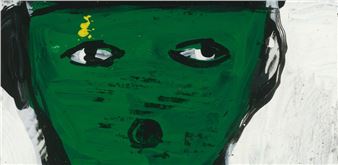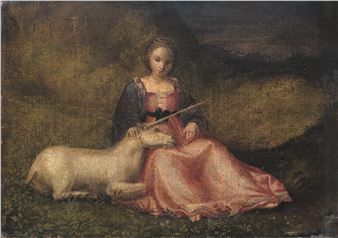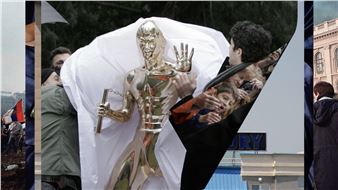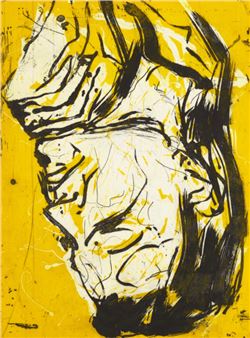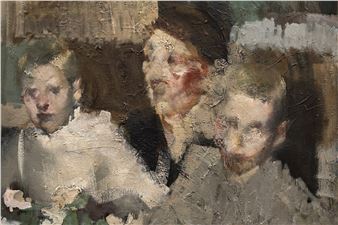Bergen Assembly
Since its founding in 1838, Bergen Kunsthall has been a key space for artistic experimentation and for the collective cultural life of the city, with many generations of artists continually reshaping the institution as they‚Äôve set about reimagining art‚Äôs role in civic space and the public sphere. For ‚Äúacross, with, nearby‚ÄĚ, the Kunsthall‚Äôs activities encompass all of its exhibition spaces as well as its bookshop, while also hosting an extensive programme of events. Foregrounding practices that encourage ways to relate to and learn with others, the Kunsthall becomes a site that connects historical and contemporary approaches to collective work, sharing ‚ÄĒ as a counterpoint to showing ‚ÄĒ visual culture, situated knowledge, and social justice.
A spectrum of engagements takes place across collective action experiments and anti-colonial movements. These include a retrospective of Gruppe 66’s work, including documentation of their situationist methods of co-ritus at Bergen Kunsthall in the 1960s and 1970s, while inviting contemporary artists and collectives (Susan Philipsz, Maasai Mbili Artists Collective, Jakkai Siributr, and Tenthaus Art Collective) to present new co-ritus events inspired by Gruppe 66. Alongside this are Vikrant Bhise’s paintings, which speak from specific sites of caste-based struggle while also acknowledging and connecting to the legacy of the Dalit Panthers. The Singing Wells Archive listening space features an extensive archive of music traditions from East Africa. Broader questions of solidarity are raised in Sajan Mani’s performances, which give voice to marginalised and oppressed communities in India, while AgriForum’s work has established an evolving network of locally rooted practices from India as a way of reflecting on, and learning with, land and community.
Ways of seeing and sharing living, relational knowledge across peoples and places are also explored at Bergen Kunsthall. √Ānddir Ivv√°r Ivv√°r/Iver J√•ks‚Äô drawings propose a blurring of the lines that separate art from artefact as experienced in S√°mi culture, and therefore hold and transmit parallel visual histories, while K√•re Alexander Grundv√•g‚Äôs earthworks engage local materials and ecologies. A collaboration between Matskogen (Food Forest) and Gram Art Project explores and shares knowledge of seed, soil, and regenerative practices. Karan Shrestha expands on a 17th-century Newari manuscript to address contemporary water issues in Nepal, connecting past and present environmental concerns.
Practices of care and conscious awareness frame Marcus Coates’s films, which challenge the stigma around mental health and use creative dialogue as a way of learning with others, while Karen Werner’s after-hours broadcasts transform the intimacy of a nightly lullaby into a public ritual of collective listening, afloat on the airwaves. The space of air is similarly conjured by Clara Hastrup’s translation of natural forces into animated anxiety. Brought together at Bergen Kunsthall, these varied practices create a shared space for revisiting collective experiments, centring marginalised forms of knowledge, and fostering care, dialogue, and responses to urgent social and ecological questions.
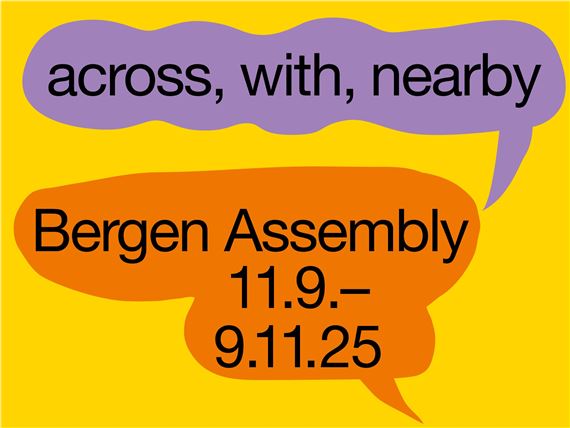
Recommended for you
Since its founding in 1838, Bergen Kunsthall has been a key space for artistic experimentation and for the collective cultural life of the city, with many generations of artists continually reshaping the institution as they‚Äôve set about reimagining art‚Äôs role in civic space and the public sphere. For ‚Äúacross, with, nearby‚ÄĚ, the Kunsthall‚Äôs activities encompass all of its exhibition spaces as well as its bookshop, while also hosting an extensive programme of events. Foregrounding practices that encourage ways to relate to and learn with others, the Kunsthall becomes a site that connects historical and contemporary approaches to collective work, sharing ‚ÄĒ as a counterpoint to showing ‚ÄĒ visual culture, situated knowledge, and social justice.
A spectrum of engagements takes place across collective action experiments and anti-colonial movements. These include a retrospective of Gruppe 66’s work, including documentation of their situationist methods of co-ritus at Bergen Kunsthall in the 1960s and 1970s, while inviting contemporary artists and collectives (Susan Philipsz, Maasai Mbili Artists Collective, Jakkai Siributr, and Tenthaus Art Collective) to present new co-ritus events inspired by Gruppe 66. Alongside this are Vikrant Bhise’s paintings, which speak from specific sites of caste-based struggle while also acknowledging and connecting to the legacy of the Dalit Panthers. The Singing Wells Archive listening space features an extensive archive of music traditions from East Africa. Broader questions of solidarity are raised in Sajan Mani’s performances, which give voice to marginalised and oppressed communities in India, while AgriForum’s work has established an evolving network of locally rooted practices from India as a way of reflecting on, and learning with, land and community.
Ways of seeing and sharing living, relational knowledge across peoples and places are also explored at Bergen Kunsthall. √Ānddir Ivv√°r Ivv√°r/Iver J√•ks‚Äô drawings propose a blurring of the lines that separate art from artefact as experienced in S√°mi culture, and therefore hold and transmit parallel visual histories, while K√•re Alexander Grundv√•g‚Äôs earthworks engage local materials and ecologies. A collaboration between Matskogen (Food Forest) and Gram Art Project explores and shares knowledge of seed, soil, and regenerative practices. Karan Shrestha expands on a 17th-century Newari manuscript to address contemporary water issues in Nepal, connecting past and present environmental concerns.
Practices of care and conscious awareness frame Marcus Coates’s films, which challenge the stigma around mental health and use creative dialogue as a way of learning with others, while Karen Werner’s after-hours broadcasts transform the intimacy of a nightly lullaby into a public ritual of collective listening, afloat on the airwaves. The space of air is similarly conjured by Clara Hastrup’s translation of natural forces into animated anxiety. Brought together at Bergen Kunsthall, these varied practices create a shared space for revisiting collective experiments, centring marginalised forms of knowledge, and fostering care, dialogue, and responses to urgent social and ecological questions.
Artists on show
- Agnes Ravatn
- AgriForum
- Bergen Kunsthall
- Christine Otten
- Clara Hastrup
- Einar Okland
- Elin Már Oyen Vister
- Elsebet Rahlff
- Gruppe K 66
- Iver Iversen Jåks
- Jakkai Siributr
- Jana Winderen
- Joar Nango
- Karan Shrestha
- Karen Werner
- Ken Are Bongo
- Koki Tanaka
- Korff Lars Lofthus
- Layli Long Soldier
- Leander Djønne
- Maasai Mbili
- Maaza Mengiste
- Marcus Coates
- Mohamedou Ould Slahi
- Monica Ursina Jäger
- Philip Rizk
- Prabhakar Pachpute
- Sajan Mani
- Saman Khosravi
- Sarah Kazmi
- Shahram Khosravi
- Singing Wells
- Susan Philipsz
- Tomas Espedal
- Tora Sanden Doskeland
- Vikrant Bhise
Related articles
Bergen Assembly sets out to gather allies for a feat of collective thinking.

 ARTISTS
ARTISTS








